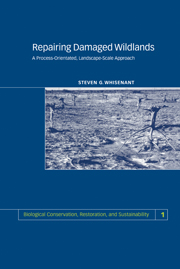Book contents
- Frontmatter
- Contents
- Preface
- Acknowledgments
- 1 Wildland degradation and repair
- 2 Assessing damage to primary processes
- 3 Repairing damaged primary processes
- 4 Directing vegetation change
- 5 Selecting plant materials
- 6 Site preparation and seedbed management
- 7 Planting
- 8 Planning repair programs for wildland landscapes
- Literature cited
- Index
1 - Wildland degradation and repair
Published online by Cambridge University Press: 03 December 2009
- Frontmatter
- Contents
- Preface
- Acknowledgments
- 1 Wildland degradation and repair
- 2 Assessing damage to primary processes
- 3 Repairing damaged primary processes
- 4 Directing vegetation change
- 5 Selecting plant materials
- 6 Site preparation and seedbed management
- 7 Planting
- 8 Planning repair programs for wildland landscapes
- Literature cited
- Index
Summary
Introduction
Wildlands are forests, grasslands, savannas, deserts, wetlands, shrublands, marshlands or other extensively managed areas for which a selfsustaining, and usually perennial, vegetation is the management objective. They often have a relatively low productivity and/or produce goods and services with relatively low market values. However, wildlands, which comprise most of the earth's land area, are very important because they provide food, fiber, recreational amenities, contribute to biological diversity, and control the quality and amount of water for many urban and agricultural uses.
Although initial degradation of wildland ecosystems alters species composition, those areas initially retain control over essential resources (i.e., soil, water, nutrients, and organic materials). Degradation becomes more severe as the area loses control over essential resources (Chapin et al., 1997). Seriously damaged wildlands not only lost control over resources, they lost the capacity for self-repair and are unable prevent additional degradation. Thus, they are less resilient to additional stress or damage and provide fewer environmental services (Myers, 1996). As these degrading processes continue, the area crosses a threshold, beyond which it can no longer recover. This is desertification. Once begun, desertification is a dynamic, self-perpetuating process (Tivy, 1990; Thurow, 1991).
Wildland degradation has two components (socioeconomic and biophysical) that complicate its assessment. The expectations of societies or individual managers for the production of goods and services influence perceptions of wildland degradation. Species composition shifts reduce socioeconomic values without negatively affecting its ability to retain essential resources. Biophysical degradation, the primary focus of this book, occurs when wildland ecosystems lose the ability to retain essential resources. Since biophysical degradation usually has an adverse effect on socioeconomic values, it is included in most assessments of degradation.
- Type
- Chapter
- Information
- Repairing Damaged WildlandsA Process-Orientated, Landscape-Scale Approach, pp. 1 - 23Publisher: Cambridge University PressPrint publication year: 1999
- 2
- Cited by



